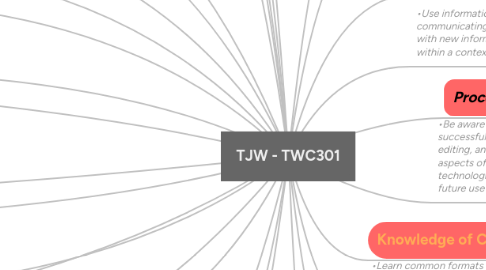TJW - TWC301
by toni tassell

1. BOD- Images chp.8
2. Flow usual & verbal paths of movement. Visual- order graphic is viewed as your eye cross the page. Verbal- How the viewer reads the taxt and how it is arranged on page. -headlines near article. -easy to read typeface. -article flow next to page use consistent treatment. -use column correct porportios. -keep items together. -keep quotes on page to reinforce info.
3. BOD-Flow chp.7
4. Principleof repititiontie together visual componentsof the design. Repeating visual elements as lines, shapes, images and textures. Unity achieved all elements as if belong together. Repeating visual aspect of the design establishes a consistent look. Ties seperate elements together.
5. Align edges Use grid to help organize design. Aligned text flush right, flush left, centered, justified, text wraps. Group realted elements together. Alignement helps with overall impression of page.
6. Why? visual weight of design. Symetrical vs. asymetrical balance. juggle visual weights of elemenet in page for balance. Sequence of how viewers view page by density & weight of item. Use picture graphic to break up monotony. Well balanced page more likey sped time reading.
7. Contrast 2 or more elements dramatically different on the page ie. small/large, all caps next lower case, thin/thick lines, warm/cool, vertical/horizontal.
8. What do you want to say Who is the audience Format Design Principle
9. Strengthen my writing skills, creatively, grammar, and constructively.
10. To be paitent, walk away if need be but, to come back and tackle the issue.
11. Do more than just gasp the knowledge and information on the internet use it well to better my career aspirations.
12. To adapt, understand, and to use information more on the internet.
13. TJW Goals for twc301
14. BOD- Design & Layout chp.1
15. BOD-Emphasis chp.2
16. Emphases is used to focus on intellectual & visual hierachy. Decide what need to be emphased & the usual hierachy used. Keep message simple & avoid emphasing everything.
17. BOD-Contrast chp.3
18. BOD-Balance chp.4
19. BOD-Alignmnet chp. 5
20. BOD-Repitition chp. 6
21. Images are powerful influence the mood of the work. Photograph- more credible. Illustrations- complement reading & text help with the message. Clip Art- Type- Rules Using: space, variety, contrast, belong, appropriate.
22. A Fair(y) Use Tale. Copy write owner only has the right to use work with persmission granted by owner. i.e. music, dance, movie & pictures. Duration 14 years long enough owner to make money then goes into public doamin. Can't apply to an idea. Fair use limitation on copyright maybe broke nature of work borrowed & what borrowed doesn't change original use value. Public Domain IS the Rule, Copyright the exception. The manifesto key elements. 1.Public domain is the rule, copyright protection is the exception. 2.Copyright protection should last only as long as necessary in protecting the author & safeguearding public intrest. 3.In the public stay in the public. 4.Lawful user of digital copy should be free to copy & modify work. 5.Contracts or technical protection measures restrict access & re use public domain. Code of Best Practice. Code define copyright doctrine. Whar this is, What this isn't, How created, Chraracteristic of the field, problems encountered fair use. Creative Commons Creative Co-ownership of documents. Copyright laws changed in the 1980's. Copyright immediately. Creative Commons some rights reserved.
23. •Learn common formats for different genres •Develop knowledge of genre conventions ranging from structure and paragraphing to tone and mechanics •Understand and apply legal and ethical uses of information and technology including copyright and intellectual property
24. •Be aware that it usually takes multiple drafts to create and complete a successful text •Develop flexible strategies for generating, revising, editing, and proof-reading •Understand the collaborative and social aspects of research and writing processes •Use appropriate technologies to manage data and information collected or generated for future use
25. •Use information, writing, and reading for inquiry, learning, thinking, and communicating •Integrate previously held beliefs, assumptions, and knowledge with new information and the ideas of others to accomplish a specific purpose within a context
26. •Identify, articulate, and focus on a defined purpose •Respond to the need of the appropriate audience •Respond appropriately to different rhetorical situations •Use conventions of format and structure appropriate to the rhetorical situation •Adopt appropriate voice, tone, and level of formality •Understand how each genre helps to shape writing and how readers respond to it •Write in multiple genres •Understand the role of a variety of technologies/media in accessing, retrieving, managing, and communicating information •Use appropriate technologies to organize, present, and communicate information to address a range of audiences, purposes, and genre
27. Rhetorical Knowledge
28. Critical Thinking Reading,& Writing
29. Process
30. Knowledge of Conventions
31. D#6HW#5- Copyright Video & Readings


